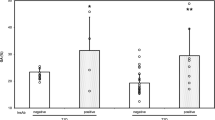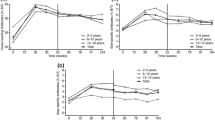Abstract
Objective
The Scatchard plot of anti-insulin antibodies is curvilinear, indicating heterogeneity in binding sites. However, the relationship between bound insulin (B) and free insulin (F) in patients with anti-insulin antibodies has not yet been elucidated. This study aimed to determine this relationship.
Methods
We studied two insulin-treated patients with diabetes who had high titers of anti-insulin antibodies. The B and F levels were measured using daily blood samples. Assuming that the law of mass action is applicable to the reactions between insulin and anti-insulin antibody forms, we plotted the bound-to-free ratio (B/F) vs. B using patient data. We also performed an equilibrium binding assay in vitro.
Results
Some of the B/F vs. B plots of the daily variation showed an approximately linear relationship, while the Scatchard plots of in vitro data became curvilinear.
Conclusion
Our study suggests that the one-site (high-affinity site) of anti-insulin antibodies accounts, for the most part, for insulin pharmacokinetics within physiological insulin concentrations.


Similar content being viewed by others
Data availability
The deidentified participant data will be shared on a request basis. Please contact Hiroyuki Asaka (daitoku@muse.ocn.ne.jp). But the data used in this study has been restricted by the Kanazawa University IRB.
References
Goldman J, Baldwin D, Pugh W, Rubenstein AH. Equilibrium binding assay and kinetic characterization of insulin antibodies. Diabetes. 1978;27:653–60.
Fineberg SE, Kawabata TT, Finco-Kent D, Fountaine RJ, Finch GL, Krasner AS. Immunological responses to exogenous insulin. Endocr Rev. 2007;28:625–52.
Berson SA, Yalow RS. Quantitative aspects of the reaction between insulin and insulin-binding antibody. J Clin Invest. 1959;38:1996–2016.
Weder HG, Schildknecht J, Lutz RA, Kesselring P. Determination of binding parameters from Scatchard plots. Theoretical and practical considerations. Eur J Biochem. 1974;42:475–81.
Sasakuma F, Matsumiya K, Onishi M, Kitamura H, Hasegawa K. Studies on insulin and anti-insulin antibody levels in sera of insulin-treated patients. Japanese J Clin Chem. 1987;16:148–55 (In Japanese).
Nakagawa S, Nakayama H, Sasaki T, Yoshino K, Yu YY, Shinozaki K, Aoki S, Mashimo K. A simple method for the determination of serum free insulin levels in insulin-treated patients. Diabetes. 1973;22:590–600.
Van Haeften TW, Krom BA, Gerich JE. Prolonged fasting hypoglycemia due to insulin antibodies in patient with non-insulin-dependent diabetes mellitus: effect of insulin withdrawal on insulin-antibody-binding kinetics. Diabetes Care. 1987;10:160–3.
Scatchard G. The attractions of proteins for small molecules and ions. Ann NY Acad Sci. 1949;51:660–72.
Motulsky HJ, Ransnas LA. Fitting curves to data using nonlinear regression: a practical and nonmathematical review. FASEB J. 1987;1:365–74.
Rosenthal HE. A graphic method for the determination and presentation of binding parameters in a complex system. Anal Biochem. 1967;20:525–32.
Van Haeften TW, Heiling VJ, Gerich JE. Adverse effects of insulin antibodies on postprandial plasma glucose and insulin profiles in diabetic patients without immune insulin resistance. Implications for intensive insulin regimens. Diabetes. 1987;36:305–9.
Van Haeften TW, Bolli GB, Dimitriadis GD, Gottesman IS, Horwitz DL, Gerich JE. Effect of insulin antibodies and their kinetic characteristics on plasma free insulin dynamics in patients with diabetes mellitus. Metabolism. 1986;35:649–56.
Eguchi Y. Scatchard analysis of insulin autoantibodies in the insulin autoimmune syndrome. J Tokyo Wom Med Univ. 1989;59:1296–305 (In Japanese).
Greenfield JR, Tuthill A, Soos MA, Semple RK, Halsall DJ, Chaudhry A, O’Rahilly S. Severe insulin resistance due to anti-insulin antibodies: response to plasma exchange and immunosuppressive therapy. Diabet Med. 2009;26:79–82.
Ismail AA. The insulin autoimmune syndrome (IAS) as a cause of hypoglycaemia: an update on the pathophysiology, biochemical investigations and diagnosis. Clin Chem Lab Med. 2016;54:1715–24.
Church D, Cardoso L, Bradbury S, Clarke C, Stears A, Dover A, Halsall D, Semple R. Diagnosis of insulin autoimmune syndrome using polyethylene glycol precipitation and gel filtration chromatography with ex vivo insulin exchange. Clin Endocrinol (Oxf). 2017;86:347–53.
Ono Y, Kume Y, Kaneko M, Nagatomo R, Yuasa K, et al. Evaluation of the reagent “Chemilumi Insulin” “Chemilumi C-peptide” by automated chemiluminescent immune analyzer ADVIA Centaur XP. JJCLA. 2013;38:51–6 (In Japanese).
Hanning I, Home PD, Alberti KGMM. Measurement of free insulin concentration: the influence of the timing of extraction of insulin antibodies. Diabetologia. 1985;28:831–5.
Oyama H, Yoneda M, Tsushima K, Matsuki M, Nishida S, Horino M. Plasma profiles of total and free insulins in diabetic patients with insulin antibodies (I): study on subcutaneous insulin administration. J Japan Diab Soc. 1990;33:379–85 (In Japanese).
Acknowledgements
We thank the patients who participated in this study.
Funding
None.
Author information
Authors and Affiliations
Contributions
HA conceived and designed the study, analyzed the data, and drafted the manuscript for publication. SK designed the study and reviewed the manuscript. DC supervised the study, contributed to discussion, and reviewed and edited the manuscript. MK, MU, KY, KA, and TY reviewed the manuscript. All authors edited, reviewed, and approved the final version of the manuscript. HA is the guarantor of this work, and, as such, had full access to all the data in the study and takes responsibility for the integrity of the data and the accuracy of the data analysis.
Corresponding author
Ethics declarations
Conflict of interest
None of the authors have any potential conflicts of interest associated with this research.
Human and animal rights
All procedures followed were in accordance with the ethical standards of the responsible committee on human experimentation (institutional and national) and/or with the Helsinki Declaration of 1964 and later versions. This study was approved by the ethics committee of Kanazawa University (approval No. 1917-1/ September 16, 2015, approval No. 1917-2/February 21, 2017).
Informed consent
Written informed consent was obtained from the patients.
Additional information
Publisher's Note
Springer Nature remains neutral with regard to jurisdictional claims in published maps and institutional affiliations.
Supplementary Information
Below is the link to the electronic supplementary material.
13340_2023_641_MOESM1_ESM.pdf
Supplementary file1 The results of the patient with type 1 diabetes mellitus who had moderate anti-insulin antibodies (Patient 3). A: Fasting data. B: Daily variation in total insulin, free insulin, and plasma glucose. C: Scatchard plot (B/F vs. B plot) and Ka and Bmax by one-site model in vivo. D: Scatchard plot using 125I-labeled porcine insulin and Ka and Bmax by the two-site model in vitro. The patient was treated with continuous subcutaneous insulin infusion with insulin lispro (4.0, 6.9, and 6.7 units before breakfast, lunch, and dinner, respectively) and total daily basal insulin (15.6 units/day). T-IRI, total immunoreactive insulin (pmol/L); F-IRI, free immunoreactive insulin (pmol/L); PG, plasma glucose (mg/dL); B, bound insulin (10−8 M); F, free insulin; B/F, bound/free ratio; Ka, affinity constant (1/10−8 M); Bmax, binding capacity (10−8 M) (PDF 68 KB)
About this article
Cite this article
Asaka, H., Karashima, S., Chujo, D. et al. In vivo relationship between bound and free insulin in patients with diabetes having anti-insulin antibodies. Diabetol Int 14, 427–433 (2023). https://doi.org/10.1007/s13340-023-00641-1
Received:
Accepted:
Published:
Issue Date:
DOI: https://doi.org/10.1007/s13340-023-00641-1




